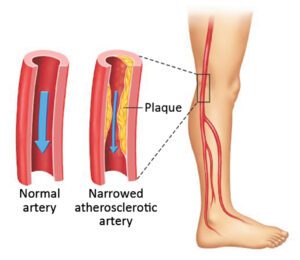By Julian J. Javier, MD, FSCAI, FACC, FACP and Leandro Perez, MD, FACC, FSCAI, RPVI


Heart disease and the issue of high blood glucose are very closely associated because of many risk factors contributing to what’s known as metabolic syndrome. Metabolic syndrome is a condition in which the high insulin and leptin levels are resistant, causing high blood pressure, high cholesterol, high triglycerides, and visceral fat to become significant risk factors for heart and vascular disorders.
In recent years, metabolic syndrome has become a commonly identified risk factor for cardiovascular disease because a vast number of Americans are overweight, and their bodies become inflamed; this inflammatory response affects the vascular structures. When the vessels are circulating high-glucose blood, atherosclerosis occurs at a greater intensity. Atherosclerosis is a build-up of plaque and causes a hardening of the arteries.
Unfortunately, sugar and simple carbohydrates (crackers, cookies, and bread) have become a significant staple in the American diet. The normal fasting blood sugar levels should be around 70-99 mg/dl. The normal A1C, which measures the blood glucose level should be below 5.7%. With diabetes and even prediabetes, these levels are at an unhealthy height and can be very hard to lower without major intervention with medication, exercise, dietary changes, and a lifestyle overhaul.
Metabolic Syndrome is caused by high lipid counts, high blood sugar, being overweight, eating a poor diet (sugar cravings), abdominal fat, high blood pressure (greater than 130/85 mmHg), and a lack of exercise. The risks associated are heart disease, diabetes, and stroke. Once you have metabolic syndrome, you must lose weight, lower your lipid levels, and reduce hypertension and combat stress. At this point, merely lowering your blood glucose is not enough. This is precisely the reason why so many people with diabetes that reduce their blood sugar, still are at high risk for cardiac episodes.
PAD and Diabetes
Individuals with peripheral arterial disease (PAD) have blood flow disruptions usually in the feet and legs, but it can also occur in the brain, arms, and heart. When the blood vessels are narrowed or damaged (from issues like diabetes), the blood flow becomes obstructed, and other complications can coincide. PAD can lead to severe medical conditions. Currently, 8.5 million Americans have peripheral artery disease.
Individuals with arterial disease due to atherosclerosis (plaque buildup in the arteries) often have peripheral vascular disease (PVD) as well. Where other blood vessel conditions like DVT’s (Deep Vein Thrombosis) varicose veins, pulmonary embolisms, and venous insufficiency are interrelated.
Symptoms of PAD
• Claudication (leg and calf pain while walking)
• Weak pulse on ankle or foot
• Hair loss on legs and feet
• Leg pain while standing or sitting, which subsides after resting for an
• extended period of time
• A sensation of tightness & burning may occur in the leg or foot
• Swelling of the calves, which dissipates after elevation
• Dark veins
• Dry, itchy skin
• Ulcers can occur near the ankle and are often painless, but may have a dark rim
• Shortness of breath
Treating PAD
Treatment for PAD traditionally consists of reducing and preventing symptoms. This approach is usually taken in a bevy of different ways. There are several levels of treatments. First, come lifestyle changes.
If necessary, your doctor may also prescribe high cholesterol or blood pressure medications. And, should your PAD continue to progress, there are several non-invasive procedures that can alleviate symptoms as well.
Lifestyle Changes
Very often, PAD is targeted with several lifestyle changes and an exercise regimen. However, if you currently smoke or use tobacco, then you should cease and consider smoking cessation counseling. This will also help any co-morbid diseases that come with PAD, such has Coronary Heart Disease, Hypertension, Hypercholesterolemia, etc.
More than this, making the right food choices and walking or other forms of cardiovascular exercise will go a long way in controlling PAD. Taking an aspirin or other anti-platelet medications will also ease any ongoing symptoms of PAD and help prevent any complications from arising.
Julian Javier, MD | Leandro Perez, MD
Dr. Julian J Javier and Dr. Leandro Perez are Cardiac and Vascular specialists with a special emphasis on limb preservation and venous disorder. Dr. Javier and Dr. Perez are board certified in cardiovascular disease and are well known nationally and internationally, authors of multiple articles in prestige peer review journals and book chapters on venous and arterial disease. They are affiliated with Physicians Regional Medical Center and Collier Regional and are accepting new patients.
To Schedule your appointment with Dr. Javier or Dr. Perez, please call (239) 300-0586.
Naples Cardiac and Endovascular Center
www.heartvein.com
1168 Goodlette-Frank Rd N Naples, FL 34102
(239) 300-0586
 Southwest Florida's Health and Wellness Magazine Health and Wellness Articles
Southwest Florida's Health and Wellness Magazine Health and Wellness Articles
